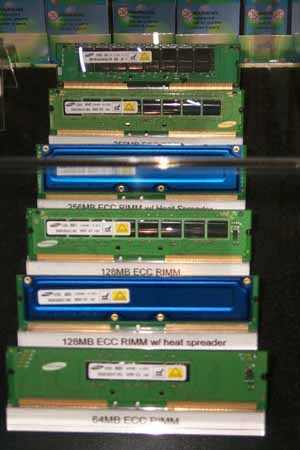Rambus DRAM: Uncovering Facts & Burying Rumors
by Anand Lal Shimpi on May 15, 2000 12:27 AM EST- Posted in
- Memory
Power & Heat
Whenever a new product is on the verge of being released, there are always rumors about it overheating or it requiring some insane form of cooling. We saw this with the Voodoo3 that was not equipped with a fan, although the chip didn't require one, 3dfx was often bashed for failing to include one. The first thing you have to understand is that a good engineer will not allow a product to be released in a state where it could potentially overheat. With that said, let's look at the power draw and heat dissipation characteristics of RDRAM.
Remember that RDRAM is a serial device, so at any given time, you're transferring one bit of data at a time instead of transferring multiple data bits in parallel, which is the case in SDRAM. Because of the way RDRAM works, only one device (RDRAM chip on a module) can be active at one time – by active we mean actively transferring data. The rest of the devices on the module are in one of four power modes, Power Down, Nap, Standby or eventually in Active where reading/writing can take place.
According to the PC100 specification, you're looking at about 900mW of power required per SDRAM chip (device) on a module. All of the devices draw the same amount of power, meaning that they're all drawing 900mW. This isn't the case for RDRAM.
On a RDRAM module, you have one device active at any given time; let's just assume that you have an RDRAM module with 8 devices, the active device will pull around 1165mW of power, but depending on the state of the rest of the devices, they could be consuming between 10mW (Nap) and 250mW (Standby) as well as the 1165mW (Active) assuming normal operation. So overall, an RDRAM module will draw less power than a PC100 SDRAM module.
But then what's the point for the blue heatsink that's present on RDRAM modules?
It's actually not a heatsink, but rather a heat spreader. The heat spreader is bolted onto the RDRAM module (after the RDRAM devices are all individually tested but not after the module itself without the spreader has been tested) and doesn't actually make physical contact with the RDRAM devices, instead it uses a thermal pad that makes contact with the devices and then touches the underside of the heat spreader.
What this heat spreader helps to do is essentially "spread" out the heat from the one concentrated source (the one active RDRAM device) across a larger surface area. If you touch an RDRAM module during heavy operation, it never gets more than warm to the touch, so the rumors of RDRAM being hot enough to cook eggs on are seriously exaggerated (the Cyrix 6x86 was the only CPU worthy of that title ;)…).











1 Comments
View All Comments
dylan522p - Wednesday, December 11, 2013 - link
Wow I wish I read this all those years ago.